As a further prey merchandise for wolves, bears and cougars, equids could artificially increase predator numbers within the space
Feral horses could outcompete native ungulates and cattle within the grasslands of Alberta east of the Rocky Mountains.
Their presence might also artificially subsidize predators like bears and wolves within the space, who could in flip devour extra elk and bighorn sheep.
“We discovered proof that feral horses could also be affecting native species each in obvious competitors and competitors for forage,” stated TWS member Birch Gano, a grasp’s scholar on the College of Montana.
Wildlife professionals have printed an excessive amount of analysis on the results that feral horses (Equus caballus) have on native wildlife and crops within the western United States. However much less work has been performed on their ecological affect in Alberta, the place they quantity round 1,500 people.
Horses off the ranch
Gano, who grew up in Alberta within the foothills of the Rockies, was finding out elk (Cervus canadensis) on the Ya Ha Tinda Ranch, a Parks Canada ranch the place horses are saved for the winter for wardens for neighboring Banff Nationwide Park and researchers going into the backcountry. Other than the corralled space for domesticated horses, the ranch has practically 4,000 hectares that elk and bighorn sheep (Ovis canadensis) use. “It’s a very fashionable spot to take horses and go using,” Gano stated. “In the summertime, it’s fairly busy with recreation.” The elk there are partially migratory, heading to the east of the ranch the place they usually encounter feral horses within the spring and summer season.
Gano puzzled how the presence of so many horses within the space would possibly have an effect on the native ungulates. “Driving out to the research space, it was loopy to see what number of horses there have been,” she stated.
Her supervisor on the College of Montana didn’t wish to contact the subject as a consequence of controversy over feral horses, however Gano determined to investigate information that researchers had been amassing within the space for the previous 10 years as a part of a long-term elk undertaking at Ya Ha Tinda. Researchers had been monitoring the world utilizing 23 path cameras since 2013. Gano supplemented this information by amassing scat from ungulates, home cattle and carnivores on the ranch from 2022 to 2025.
In ongoing analysis Gano introduced on the 2025 TWS Convention in Edmonton, Alberta, she has discovered that feral horse weight-reduction plan overlaps considerably with native elk and bighorn sheep, particularly within the winter and spring, in areas east of Ya Ha Tinda. Elk additionally appeared to keep away from the areas that feral horses foraged in, lacking out on good feeding alternatives.
However the feral horses and home cattle had a bonus over native ungulates. Scat evaluation revealed that they made meals of extra nonnative forage crops like dandelions and clover, which native ungulates don’t eat. This conduct helps horses outcompete the native ungulates and boosts the unfold of those crops, because the horses unfold the seeds round extra broadly.
“It’s like this complete ecological arms race,” Gano stated.
Horse meat menu
Gano additionally puzzled whether or not horses themselves had been on the menu for predators in Alberta. Evaluation of carnivore scat revealed that each predator within the space ate horses at the least often. “Horses had been a giant a part of [the] carnivore weight-reduction plan,” Gano stated.
Horse represented 1 / 4 of the grey wolf (Canis lupus) weight-reduction plan and a few third of grizzly bears’ (Ursus arctos horribilis) meat diets.
Horses had been solely present in about 5% of cougar (Puma concolor) scat and in a few quarter of coyote (C. latrans) scat. The latter is probably going largely scavenging, Gano stated, as coyotes are in all probability too small normally to prey on horses.
A few of the different predators might simply be scavenging a few of their horse meat—it’s troublesome to say primarily based simply on scat evaluation. “Probably, cougars are killing their very own prey in addition to wolves,” Gano stated.
Whereas this example could appear to be native predators are removing the inhabitants of an invasive species, Gano stated that this injection of prey could increase the variety of some predators, which can then feed on extra native prey in addition to horses. This dynamic is already well-known in elements of northern Alberta, the place an inflow of white-tailed deer (Odocoileus virginianus) is driving a rise in wolf numbers, which then prey on extra caribou (Rangifer tarandus) as a secondary prey merchandise.

Gano stated it’s too early to inform for positive whether or not feral horses are inflicting an identical drawback with predators, elk and bighorn sheep in her research space, however “wolf and grizzly predation are the main reason behind declines within the elk populations,” she stated. “[Our study] is a stepping stone into unraveling this obvious competitors pathway that we all know in Alberta so nicely.”
The truth that there could also be competitors between feral horses and native species in Alberta is a wake-up name for wildlife managers within the province, which presently does nothing to manage numbers there. “They’re presently evaluating completely different administration trade-offs,” Gano stated.
